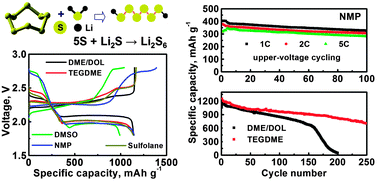A class of polysulfide catholytes for lithium–sulfur batteries: energy density, cyclability, and voltage enhancement†
Abstract
Liquid-phase polysulfide catholytes are attracting much attention in lithium–sulfur (Li–S) batteries as they provide a facile dispersion and homogeneous distribution of the sulfur active material in the conductive matrix. However, the organic solvents used in lithium–polysulfide (Li–PS) batteries play an important role and have an impact on the physico-chemical characteristics of polysulfides. For instance, significantly higher voltages (∼2.7 V) of the S/Sn2− (4 ≤ n ≤ 8) redox couple are observed in Li–PS batteries with dimethyl sulfoxide (DMSO) and N-methyl-2-pyrrolidone (NMP) solvents. Accordingly, high power Li–PS batteries are presented here with the catholyte prepared with NMP solvent and operated with the highly reversible sulfur/long-chain polysulfide redox couple. On the other hand, a remarkable cyclability enhancement of the Li–PS battery is observed with the long-chain, ether-based tetraglyme (TEGDME) solvent. The voltage enhancement and the cyclability enhancement of the Li–PS batteries are attributed to the solvation effect, viscosity, and volatility of the solvents. Finally, highly concentrated polysulfide catholytes are successfully synthesized, with which high energy density Li–PS batteries are demonstrated by employing a multi-walled carbon nanotube (MWCNT) fabric electrode.


 Please wait while we load your content...
Please wait while we load your content...